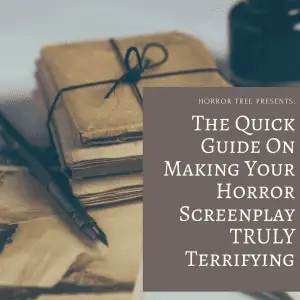Quick Guide On Making Your Horror Screenplay TRULY Terrifying
 Quick Guide On Making Your Horror Screenplay TRULY Terrifying
Quick Guide On Making Your Horror Screenplay TRULY Terrifying
If you like watching scary movies, and you know your way around the formula that creates the best horror, then you might be interested in writing your own horror screenplay. A horror screenplay is special to write, because you’re not only telling the story, but you’re also giving your audience a good scare.
In this quick guide, we’ll show you 7 tips on how to craft a good horror screenplay.
- Take Inspiration From Your Own Fears
“First, when writing a horror screenplay, learn from your own fears,” says Taj Crookes, an arts writer at Boomessays and Essayroo. “When you explore your own fears, you’ll most likely get other people who have the same fears as you. That personal connection alone adds to your screenplay.”
- Learn From Your Favorite Horror Films
There’s a good chance that you’ve seen a lot of horror movies in your life. If you have, then first and foremost, well done!
So, now that you’re interested in writing your own horror screenplay, you can take inspiration from your guilty pleasures in the horror genre. Keep in mind: You’re not copying current or past horror movies; you’re taking notes on those films have scared you and or everyone else. As you learn from your horror favorites, you can add your own spin to the things you like about the genre.
- Don’t Just Tell A Story
When writing a horror screenplay, you’re not just telling a story; you’re also giving audiences an adrenaline rush. While story and character arcs are still important, your main job here is to make the unsettling and adrenaline-inducing aspects of a horror story front and center.
- Have Room For Empathy
There’s nothing wrong with people feeling empathy for certain characters in a horror movie. Even in dire situations, audiences will feel for certain characters, because they can relate to some of the same fears as that of said characters.
That’s why it’s important to let audiences feel like they should emphasize with characters. Having unlikeable characters can damper your chances of creating an empathetic atmosphere for audiences to get behind.
- Play With People’s Emotions
Emotions play a huge role in horror movies, because they affect how the viewer feels about something that’s on screen. Emotions make viewers think about what’s going on. Say, they see something on screen that legitimately scares them, then they’ll start having all (or some) of these feelings:
- Afraid
- Angry
- Anxious
- Sad, etc.
If you tug your audience’s heartstrings, or pick at some of their other emotional chords, then you’ve succeeded in playing with their emotions.
- Have A Good Balance Of Horror And Humor
“With a horror screenplay, you can’t heavily rely on horror,” says Alyssa Howden, a script writer at Paper Fellows and State of writing. “Plus, you can’t make your horror cheesy either. You’ll need to balance both horror and humor. While horror can be used to deliver the scares, humor can be used to regulate the story’s horror levels. So, in short, don’t make it too scary, and don’t make it too cheesy.”
- Accept Any And All Feedback
Finally, you’ll need as much feedback on your horror screenplay as you can get. It’s a fact that all screenplays – including horror – have to have some form of feedback from peers.
Now, don’t worry if you receive criticism from your peers. Remember: People are there to help you succeed in screenplay writing. All feedback should be respected.
As a screenwriter, you’ll receive plenty of feedback from:
- Peers
- Mentors
- Professionals
- Producers
- Executives, etc.
Be ready to answer any questions that people might have about your screenplay. For example, someone may ask “Why do you feel that needles are scary?” Perhaps you can explain further on why needles are scary. Maybe you can think back at some childhood memories of you being terrified of getting shots at the doctor’s office.
Also, take notes of the feedback that you’ve received from different people. As you collect your feedback, you can get a consensus of what’s working, and what you still need to work on.
Conclusion
So, there you have it!
Horror is a fun genre to work with, because your main job is to terrify your viewers in any shape or form. With these 7 tips in mind, you can write a horror screenplay that will not only terrify audiences, but also have them coming back for more!
So, good luck, and let your horrific imaginations run wild!
Elizabeth Hines is a writer and editor at UK Writings and Academized. She is also a contributing writer at OX Essays. As a digital marketer, she helps companies improve their marketing strategies and concepts.
- About the Author
- Latest Posts
The Horror Tree is a resource for horror authors which was created in 2011. The main goal when starting the site was to include all of the latest horror anthologies and publishers that are taking paying submissions. A resource useful for both new and experienced publishers alike looking for an outlet for their written material!












